The ASUS Maximus VIII Impact Z170 ROG Mini-ITX Motherboard Review
by Ian Cutress on December 29, 2015 9:00 AM ESTSystem Performance
Not all motherboards are created equal. On the face of it, they should all perform the same and differ only in the functionality they provide - however this is not the case. The obvious pointers are power consumption, but also the ability for the manufacturer to optimize USB speed, audio quality (based on audio codec), POST time and latency. This can come down to manufacturing process and prowess, so these are tested.
Power Consumption
Power consumption was tested on the system while in a single MSI GTX 770 Lightning GPU configuration with a wall meter connected to the OCZ 1250W power supply. This power supply is Gold rated, and as I am in the UK on a 230-240 V supply, leads to ~75% efficiency > 50W, and 90%+ efficiency at 250W, suitable for both idle and multi-GPU loading. This method of power reading allows us to compare the power management of the UEFI and the board to supply components with power under load, and includes typical PSU losses due to efficiency. These are the real world values that consumers may expect from a typical system (minus the monitor) using this motherboard.
While this method for power measurement may not be ideal, and you feel these numbers are not representative due to the high wattage power supply being used (we use the same PSU to remain consistent over a series of reviews, and the fact that some boards on our test bed get tested with three or four high powered GPUs), the important point to take away is the relationship between the numbers. These boards are all under the same conditions, and thus the differences between them should be easy to spot.
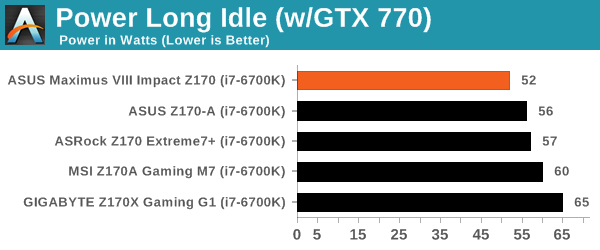
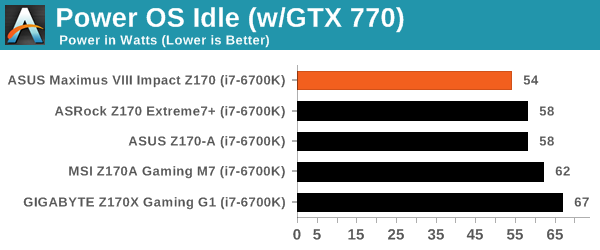
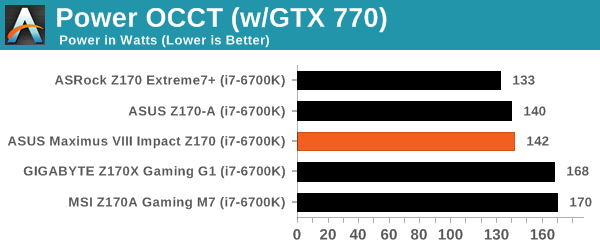
The Impact uses MultiCore Turbo, which typically increases the voltage at load to ensure a consistent top multiplier no matter what the loading is. The result of this increased performance is typically increased power consumption, and we’ve seen motherboards cause the i7-6700K CPU to consume 76W (from idle to OCCT load) up to 110W. With the Impact, perhaps due to its size, makes that delta only 90W, which isn’t as good as the non-MCT motherboards, but it currently the best MCT motherboard for power draw we’ve tested.
Non UEFI POST Time
Different motherboards have different POST sequences before an operating system is initialized. A lot of this is dependent on the board itself, and POST boot time is determined by the controllers on board (and the sequence of how those extras are organized). As part of our testing, we look at the POST Boot Time using a stopwatch. This is the time from pressing the ON button on the computer to when Windows 7 starts loading. (We discount Windows loading as it is highly variable given Windows specific features.)
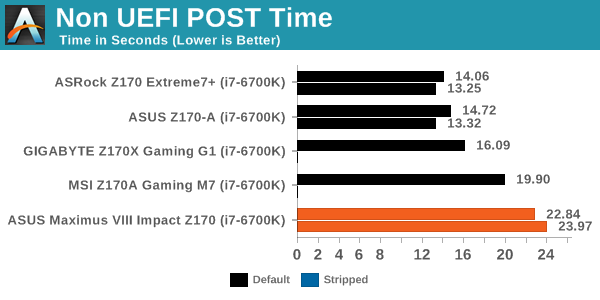
Anything over 20 seconds for a mainstream motherboard is usually seen as odd, which is why question marks come over the Impact sitting at 22 seconds when the Maximus VIII Extreme (which is being tested) only needs 16.50 seconds.
Rightmark Audio Analyzer 6.2.5
Rightmark:AA indicates how well the sound system is built and isolated from electrical interference (either internally or externally). For this test we connect the Line Out to the Line In using a short six inch 3.5mm to 3.5mm high-quality jack, turn the OS speaker volume to 100%, and run the Rightmark default test suite at 192 kHz, 24-bit. The OS is tuned to 192 kHz/24-bit input and output, and the Line-In volume is adjusted until we have the best RMAA value in the mini-pretest. We look specifically at the Dynamic Range of the audio codec used on board, as well as the Total Harmonic Distortion + Noise.
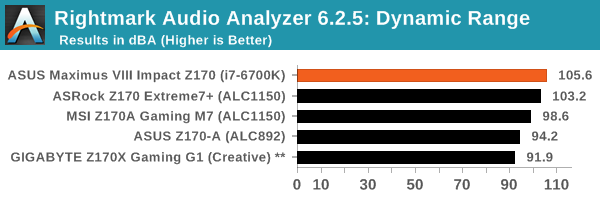
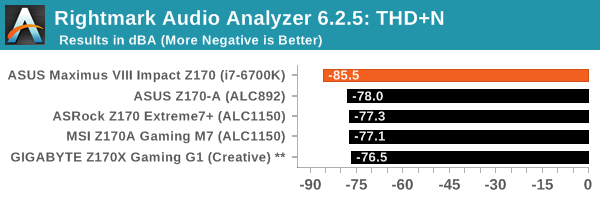
ASUS’ audio results in our test keep hitting high notes (pun intended), and the Impact is no different with a good SNR but also great distortion numbers.
USB Backup
For this benchmark, we transfer a set size of files from the SSD to the USB drive using DiskBench, which monitors the time taken to transfer. The files transferred are a 1.52 GB set of 2867 files across 320 folders – 95% of these files are small typical website files, and the rest (90% of the size) are small 30 second HD videos. In an update to pre-Z87 testing, we also run MaxCPU to load up one of the threads during the test which improves general performance up to 15% by causing all the internal pathways to run at full speed.
Due to the introduction of USB 3.1, as of June 2015 we are adjusting our test to use a dual mSATA USB 3.1 Type-C device which should be capable of saturating both USB 3.0 and USB 3.1 connections. We still use the same data set as before, but now use the new device. Results are shown as seconds taken to complete the data transfer.
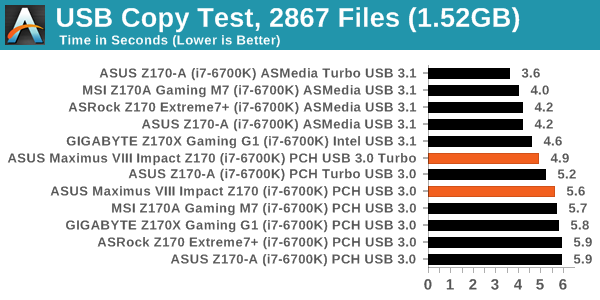
The USB 3.0 performance for the Impact was good to take top spot in our non-Turbo testing, but we had issues on the Impact testing the Alpine Ridge controller in USB 3.1 mode, as well as either mode using the Boost software. The test would end quickly, but say all the data is transferred and yet the drive is still working, showing that reporting the complete transfer is happening before the data is committed. Thus always make sure the drive is finished before removing! It also means we can’t run our tests properly.
DPC Latency
Deferred Procedure Call latency is a way in which Windows handles interrupt servicing. In order to wait for a processor to acknowledge the request, the system will queue all interrupt requests by priority. Critical interrupts will be handled as soon as possible, whereas lesser priority requests such as audio will be further down the line. If the audio device requires data, it will have to wait until the request is processed before the buffer is filled.
If the device drivers of higher priority components in a system are poorly implemented, this can cause delays in request scheduling and process time. This can lead to an empty audio buffer and characteristic audible pauses, pops and clicks. The DPC latency checker measures how much time is taken processing DPCs from driver invocation. The lower the value will result in better audio transfer at smaller buffer sizes. Results are measured in microseconds.

ASUS has been on a recent march towards low DPC numbers, and the Impact scores under 50 microseconds, making it one of our best ever results. The victory is short lived however, as we’re currently testing the Maximus VIII Extreme, and that scored under 25.










42 Comments
View All Comments
FelixDraconis - Wednesday, December 30, 2015 - link
Agreed with Mr. Elmore, but let me clarify. I'm a game programmer, myself. No, I do not have a college degree. I started too early for that. Writing clean documentation for others is one of the most important things I strive for. Picking good metaphors is also of vital importance. All things very similar to writing tech articles.Sure, some of my comments may be pedantic, but I'd rather have feedback than silence from my audience. I just hope that Mr. Ian will ponder them and decide to improve. We stop living when we stop learning. Anyway, I really just wanted to help. Anandtech is one of the best websites out there for tech articles and probably a great career builder.
Personally speaking, I stopped reading the text because it was hard to decipher. So, I suspect others would, too. Kind of defeats the purpose of writing it. Good luck, Mr. Ian!
mapesdhs - Wednesday, December 30, 2015 - link
Felix, personally I find your comments most welcome, better writing should be encouraged. Brevity is in short supply these days.SpartyOn - Tuesday, December 29, 2015 - link
I'm waiting for Nvidia Pascal to drop before updating my mini ITX Asus P8Z77-i Deluxe Ivy Bridge system. This review will heavily influence my opinion when it comes time to purchase. Looks pretty good to me.TheSlamma - Tuesday, December 29, 2015 - link
Ugh, Killer network cards SUCK Intel all the way homejasonelmore - Tuesday, December 29, 2015 - link
Asus never use Killer network cards, that's a MSI thing.. All Asus ROG boards use Intelmapesdhs - Wednesday, December 30, 2015 - link
I bought an MSI gaming laptop which has Killer E2400/wifi, works very well IMO. Far better wifi range than I've ever had before with a laptop, good GigE speeds too.mapesdhs - Wednesday, December 30, 2015 - link
Back in the Z97 era, I was pondering a Maximus VII IMPACT, but in the end I bought the ASUS Z97I-Plus instead, and very happy I am with it too. Many of the same features, cheaper, etc.Reading this article, I wondered if there was a S1151 equivalent; well, almost, namely the H170I-PLUS D3. Ian, Iike these top-end miniITX reviews, but it'd be nice to compare to something a bit further down the range. Afterall, the M8I doesn't have M.2, whereas the Z97I-Plus, and the newer H170I-Plus D3 both do have it, so the latter is surely worth of consideration.
mapesdhs - Wednesday, December 30, 2015 - link
(rats, still no edit function! Can we please make that a priority for AT in 2016? I meant to say, I like these top-end miniITX reviews, etc.)legolasyiu - Tuesday, January 5, 2016 - link
Ian, I bet your POST time will be better if you upgrade BIOS to 1302,Maximus VIII Impact BIOS 1302
1. Improve system stability
Visual - Wednesday, January 6, 2016 - link
Fun times, when "low end" gets to run 30fps on ultra, be it on a "low" resolution (that's still classified as HD, mind you).And the cherry on top is that even IGPs can finally do that, now if only they actually were put into some products... I wonder, why Intel seems to be purposely hiding the good Iris chips?